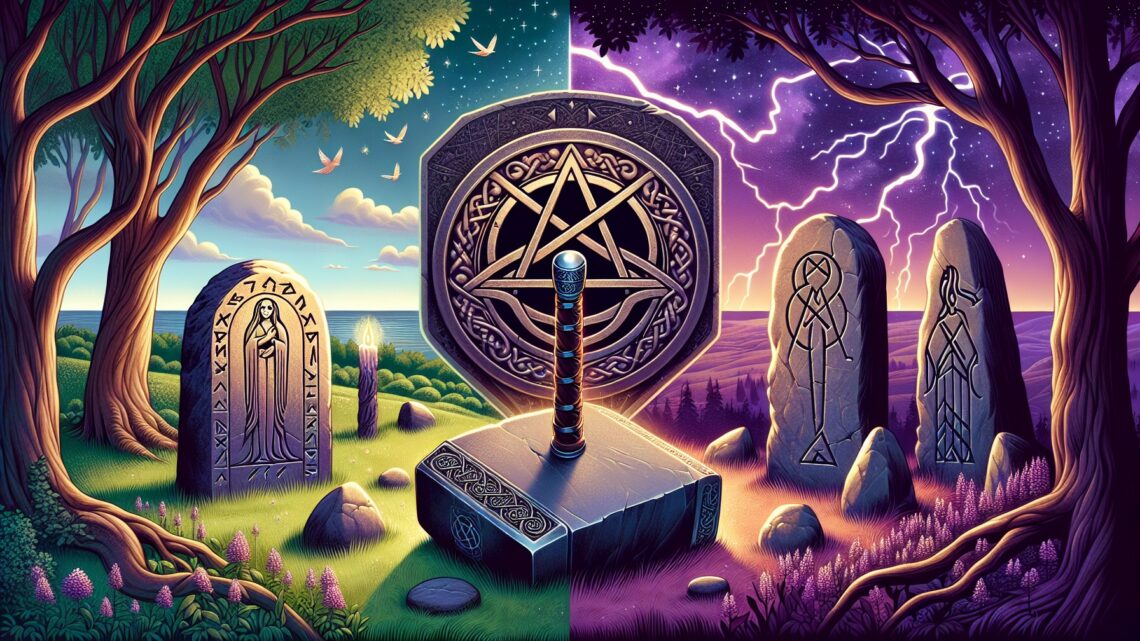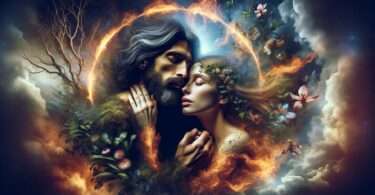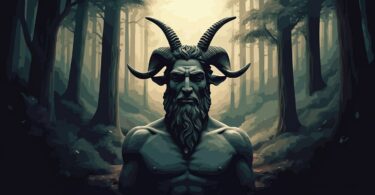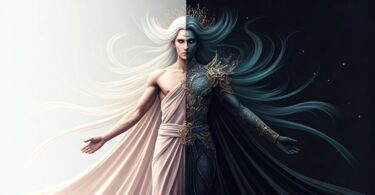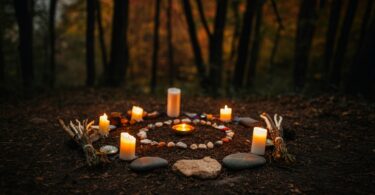Heathenry refers to forms of Norse and Germanic pagan reconstructionism, including Asatru, the Troth, Odinism, and Theodism. Heathenry is distinct from Neo-Paganism in a number of ways. A comparison of the two may be instructive for understanding Neo-Paganism.
Community
According to religious studies scholar and Heathen priest, Galina Krasskova, Heathenry was originally conceived, not as an individual spiritual practice, but as an expression of group identity, often a racial or ethnic identity. Heathenry tends to be community-centered, whereas Neo-Paganism tends to be Earth-centered or Self-centric.
Theology
According to Gillete and Lewis, in their essay, “The Pentagram and the Hammer,” Neo-Paganism is predominately pantheistic, while Heathenry is polytheistic. Neo-Pagans tend to view divinity as a unity behind a plurality of manifestations, a unity that is co-existent with nature or the universe, and thus pantheistic.
Heathens, in contrast, do not view the gods as “aspects” of a single or dual god-form. Heathens view the gods as separate and distinct individuals, much in the same way that most ancient pagans did. The Heathen conception of distinct divinities naturally leads to a view of a world in conflict, just as conflict arises in the world of individual human beings.
Thus, where Neo-Pagans see essential unity and harmony, Heathens find essential disunity and disharmony. While there is opposition (or creative tension) within the Neo-Pagan cosmologies—light and dark, masculine and feminine, summer and winter, Oak King and Holly King—this opposition is conceived as a complementary polarity within a balanced cycle. There is no such balance in Heathenry.
Pantheon
The veneration of a Mother Earth Goddess is not a central feature of Heathenry, as it is in Neo-Paganism. The gods of Heathens tend to be the gods of war and civilization (the Norse Aesir), whereas Neo-Pagan gods tend to be gods of love and fertility (resembling the Norse Vanir).
In addition, most Heathens do not worship chthonic deities like Loki and the Jotnar (giants), who are associated with the primal forces of chaos. In contrast, Neo-Pagans are actively involved in the reclamation of chthonic deities, and have no qualm with worshiping a force of chaos, so long as it is done in balance with the worship of other forces. In fact, some Neo-Pagans would view the worship of these “shadow” elements as essential to a full spiritual practice and might view the Heathen focus on the Aesir as an imbalanced focus of the powers of consciousness, to the detriment of the unconscious powers (represented by the Jotnar/giants).
Text versus Experience
Krasskova explains that Heathens invest their texts (called the “lore”) with a normative authority that is analogous to, and may even derive from, the Biblical literalism of conservative Christianity. She goes on to explain that Heathens view mystical experience with suspicion. Heathenry’s adoption and use of the phrase, “unverified personal gnosis” (UPG) reflects this, a term that would probably never arise in Neo-Pagan discussions, because Neo-Pagans value personal gnosis and do not usually seek verification from tradition. For Heathens …
“Lore holds sway over personal experience. Personal gnosis is devalued not only because it is unverifiable by the existing sources, but because it rests on experience, emotion, and non-rational subjectivity [all categories traditionally associated with women or femininity in Western thought]. In espousing personal and direct experience with the Gods, it also presumes an authority that clearly circumvents human mores.”
In contrast, Neo-Pagans understand that all religious texts originate with someone’s personal gnosis. They, therefore, adopt a relativistic attitude toward religious texts and prioritize personal experience over tradition. Tradition is especially deemphasized when it is seen as an impediment to personal authority and direct experience of the divine. Neo-Pagans emphasize experience over dogma and doctrine.
Ecstatic Practice
On the boundary between Heathenry and Neo-Paganism lie forms of ecstatic spirituality, like oracular seidh, pioneered by Diana Paxson, and the Northern Tradition Shamanism of Raven Kaldera, which incorporates pain-based ordeals adapted from BDSM. But these practices are disfavored and even condemned by many Heathens. Krasskova explains that “the hostility toward devotional practices and other liminal practices may stem from a conflation of the receptivity in devotional [and ecstatic] consciousness with weakness, unmanliness, or submission,” characteristics that are anathema to the Heathen ideal of manhood. Seidh in particular is considered a women’s art according to Heathen lore.
Politics
Another significant difference is that Heathens generally are more politically conservative than Neo-Pagans. As Ronald Hutton explains, Wicca began as an essentially politically conservative movement and became a liberal movement of feminists and progressives in the 1960s. Krasskova explains that, unlike Neo-Paganism, Heathenry “grew not out of the counter-culture itself, but out of the conservative response to those social changes.” She describes it as “counter-counter cultural.” Some Heathens’ values resemble the “family values” of the Christian Right, including maintenance of traditional gender roles and aversion to deviation in gender identity.
The environmentalism of some European Heathens can be confusing to Americans, for whom environmentalism is associated with the political Left. In much of Europe, however, environmentalism is not seen as inconsistent with political conservativism.
Ethics
Neo-Pagan ethics tend to be highly situational and laissez-faire, and based on a principle of avoidance of harm to others. Heathens do not adhere to the concept of non-harm; rather, they embrace conflict. The “Nine Noble Virtues of Asatru” are: Courage, Truth, Honor, Fidelity, Discipline, Hospitality, Self-Reliance, Industriousness, and Perseverance. Another version reads:
“Strength is better than weakness. Courage is better than cowardice. Joy is better than guilt. Honour is better than dishonor. Freedom is better than slavery. Kinship is better than alienation. Realism is better than dogmatism. Vigor is better than lifelessness. Ancestry is better than universalism.”
While Neo-Pagans share many of these values, especially freedom and joy, they do not emphasize others, like strength. “Honor” is suggestive of a shame culture, which Neo-Pagans reject. In addition, Neo-Pagans embrace universalism, in contrast to Heathenry’s emphasis on kinship and ancestry.
Ethnocentrism
Both Heathenry and Neo-Paganism have their roots in the 19th century Romantic revival in Germany and England. During this time, there was a resurgence of interest in traditional culture and nationalism in Scandinavia, Britain, and Germany. Organized Germanic pagan revivalism appeared in Germany in the early 20th century.
Some forms of pagan revivalism and occultism played a role in the formative years of Nazism. Heathenry continues to be associated with Nazism in the minds of many people, to the chagrin of most Heathens. The appropriation of some pagan motifs by the Nazis had the unfortunate effect of tainting the entire Heathen movement in the eyes of some.
Despite some similarities in motifs and values, Heathenry did not develop out of National Socialism. It was, rather, created in the 1970s. Thereafter, Heathenry developed independently of Neo-Paganism, evolving its own ritual structure and cultural discourse. Still, Heathens are plagued by the associations with Nazism. The situation is complicated by the fact that there are some within the White-supremacist subculture who consider themselves Heathen, and there are some racist groups (such as Wotanism) that consider themselves Heathen. Heathenry, with its focus on ancestry and ethnic identity lends itself to appropriation by such groups. According to Krasskova, there exists a tension inside Heathenry between a “religiously motivated majority” and a “racially motivated minority.” The intersection of racism and Heathenry is beyond the scope of this book, but some believe the ethnic character of Heathenry is legitimate or defensible. According to Krasskova, the ethnocentricity of Heathenry is:
“an attempt by practitioners to give the religion the same legitimacy as an indigenous tradition, such as that accorded to Native American religions in the United States, Shinto in Japan, and Candomble in Brazil. Practitioners see themselves as reviving a group of religions that were once native, hence indigenous and by extension ethnic, to Northern Europe.”
However, in light of the history of White supremacy in the West, the comparison of European religions (even pre-Christian European religions) to indigenous religions is problematic at best.

